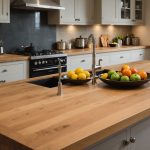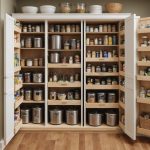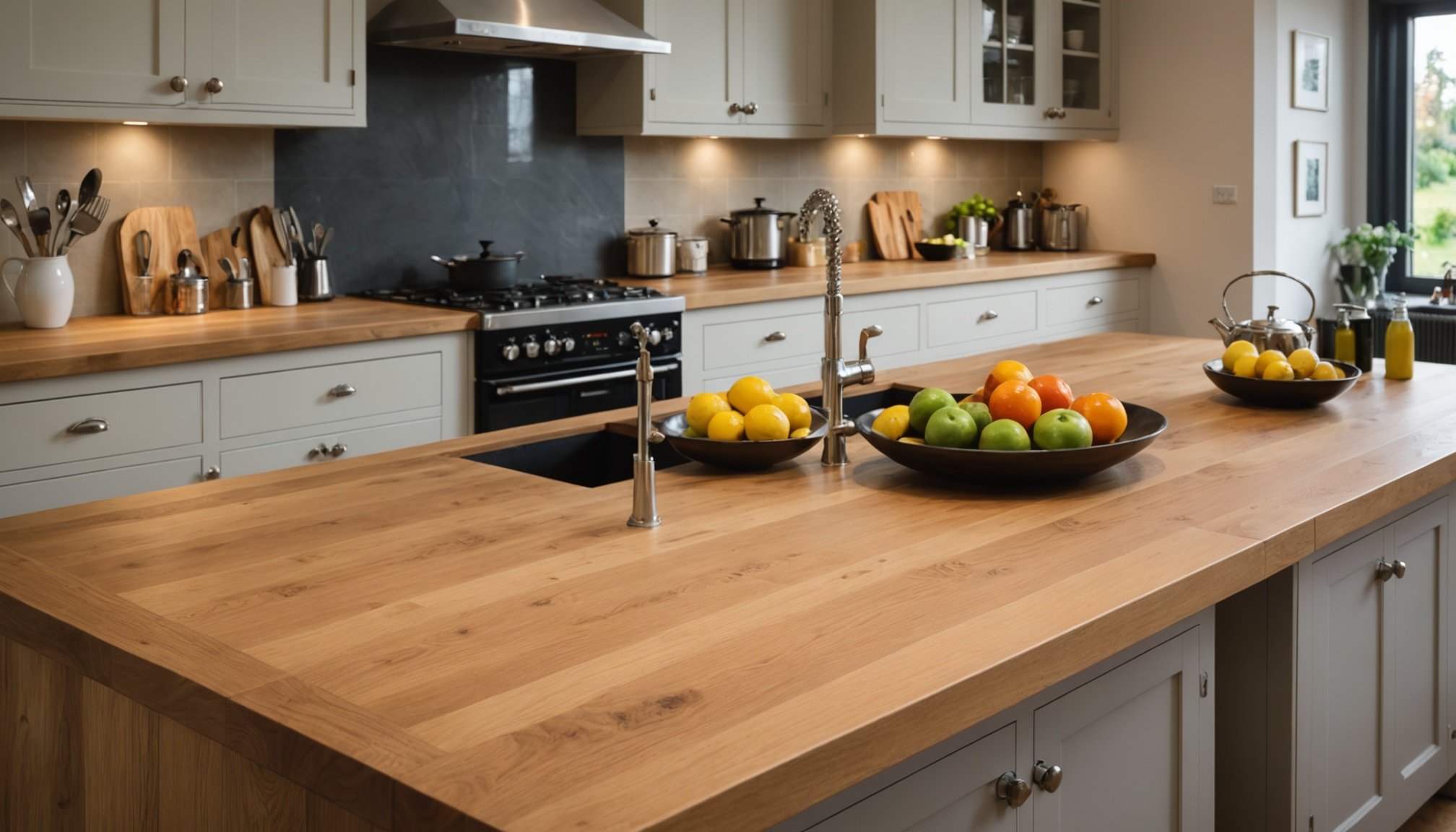Introduction to Oak Worktop Maintenance
In the realm of UK kitchen maintenance, oak worktops are a popular choice, loved for their natural beauty and durability. However, to retain their charm and extend their lifespan, oak worktop care is essential. Proper maintenance is not merely a task but a critical component of owning such a valued kitchen feature.
Effective maintenance not only preserves the aesthetic appeal but also enhances the functionality of oak worktops. Before embarking on any maintenance regime, there are several key considerations to keep in mind. Understanding the type of finish on your worktop is crucial, as it will dictate the appropriate care products and procedures. Additionally, the kitchen environment, including exposure to heat and moisture, can affect the frequency and type of maintenance required.
Topic to read : Creative pantry organization tips: space-savvy solutions for slim kitchens in the uk
An informed approach to oak worktop care involves recognizing signs of wear, such as dullness or scratches, which indicate a need for refinishing. Regular evaluation ensures that your worktop remains in optimum condition, while being proactive about maintenance tasks helps in avoiding more extensive repairs down the line. By adhering to these guidelines, you not only protect your investment but also enhance the unchanging beauty oak brings to your kitchen.
Cleaning Techniques for Oak Worktops
To keep your oak worktops looking pristine, routine cleaning is invaluable. Performing regular cleaning ensures that your worktops remain both beautiful and functional. Using suitable cleaning products is critical to avoiding damage.
Also to see : The ultimate guide to selecting ideal kitchen flooring for your uk coastal home
Daily Cleaning Practices
For everyday upkeep, wipe the surface with a damp cloth, using mild soap if necessary. This removes food particles and prevents staining. Avoid soaking the wood, as excessive moisture can lead to warping or discolouration over time.
Weekly Deep Cleaning
Designate a day each week for deep cleaning. This involves using a dedicated cleaner for oak surfaces. These products often contain natural oils that nourish the wood. Gently scrub with a soft sponge, ensuring you follow the grain of the wood.
Recommended Cleaning Products
Selecting safe cleaners is paramount. Opt for products that explicitly state they are suitable for oak. Avoid harsh chemicals like bleach or ammonia, as they can strip the wood of its protective oils. Instead, use a gentle, pH-neutral cleaner to preserve the wood’s finish. Regularly maintaining your worktops using these methods will substantially help in extending their lifespan and maintaining their attractiveness.
Oiling and Sealing Oak Worktops
To maintain the longevity and appearance of oak worktops, oiling and sealing are essential practices. Regular oiling nourishes the wood, enhances its natural beauty, and provides a protective barrier against wear and tear.
Importance of Oiling
Oiling oak worktops is crucial for keeping them hydrated and resistant to moisture. A well-oiled worktop repels spills and stains more effectively. Consistent oiling reduces the risk of cracking and preserves the wood’s natural elegance, making your kitchen more enduring and aesthetically pleasing.
Types of Oils to Use
Different oils can be utilised for treating oak. Danish oil and linseed oil are widely praised for their penetrative qualities, providing deep nourishment and a rich finish. They are safe and enhance the wood’s natural grain, offering both protection and visual appeal.
How to Properly Apply Oil
For a flawless application, clean the surface first. Apply the oil in thin layers with a clean cloth, following the wood grain. After the initial coat, let it soak, then wipe off any excess. For optimal results, repeat the procedure until the wood no longer absorbs oil, typically every six months. Watch for signs like dull areas, which indicate the need for re-oiling.
Repairing Common Damage
Owning an oak worktop in your kitchen is a delightful experience, but even with the best oak worktop care, damage can occur. Whether you’ve discovered scratches, scuffs, or watermarks, knowing how to tackle these issues is vital for preserving your worktop’s beauty.
Addressing Scratches and Scuffs
Scratches are a frequent occurrence. A simple solution is to lightly sand the affected area with fine-grit sandpaper, following the grain. Once sanded, apply a compatible wood oil to rejuvenate the surface. Small scuffs can often be buffed out with a clean cloth and some elbow grease.
Fixing Water Marks
Water marks are usually caused by moisture. To mitigate this, consider gentle sanding of the mark until it fades, followed by oiling. If discoloration persists, a specialised wood bleach might be necessary. However, it’s crucial to follow instructions carefully to avoid further damage.
Resurfacing Techniques
For more extensive damage, resurfacing might be necessary. This process involves stripping the worktop of its current finish, sanding it down, and reapplying oil or sealant. It’s a methodical approach that requires patience but can revitalise the worktop completely. If the damage is severe, seeking professional help is recommended to ensure the best results.
Preventing Future Damage
While maintaining the beauty of your oak worktops, preventing damage is just as crucial as repair. Employing proper maintenance tips enhances both the longevity and aesthetics of these kitchen essentials.
Best Practices for Usage
To avoid unnecessary damage, use cutting boards consistently rather than chopping directly on the worktop. This practice minimises scratches and dents. Applying coasters under drinks can also prevent moisture rings that might discolour the surface. Such cautious use helps preserve the worktop’s pristine condition.
Managing Heat and Moisture
Managing heat and moisture is equally vital. Always use protective mats under hot pots or pans to prevent heat damage. Promptly drying spills with a soft cloth is essential, as this prevents potential warping or staining caused by liquid seeping into the wood.
Recommended Accessories
Investing in certain accessories can make a notable difference. Consider using pads under appliances to distribute weight evenly and protect the surface from pressure marks. Moisture barriers or sealants can further shield against the perils of a humid kitchen environment.
By incorporating these strategies and tools, you’ll provide a robust defence against everyday wear and tear, ensuring your oak worktops remain stunning for years to come.
Common Issues with Oak Worktops
Experiencing common oak worktop issues can be frustrating for homeowners. Understanding these challenges, from warping to stains, helps in troubleshooting and maintaining the worktop’s appeal.
Identifying Wear and Tear
Signs of wear and tear include scratches, scuffs, and dull patches. Identifying these early is key to preventing more severe damage. Regular checks and treating issues as they arise can extend the worktop’s life.
Solutions for Warping or Cracking
Warping often results from moisture exposure or insufficient sealing. To rectify this, ensure your worktop is properly sealed and avoid excessive moisture contact. Cracks can be addressed by applying a filler or contacting a professional for significant damage.
Dealing with Stains
Stains can tarnish the beauty of oak worktops. For minor stains, use a soft cloth with mild detergent. For stubborn marks, gentle sanding and re-oiling can restore the surface. Avoiding spills and cleaning them promptly is essential for prevention.
By understanding these issues, homeowners can implement effective troubleshooting solutions, ensuring their oak worktops remain beautiful and functional for years. Proactive maintenance and attention to detail play a crucial role in preserving the aesthetic and structural integrity of oak surfaces.
Recommended Products and Tools
Maintaining the allure of oak worktops requires using quality products and tools. Choosing the right items simplifies the process and enhances the effectiveness of your maintenance routine.
Cleaning Supplies
To clean oak worktops effectively, ensure you have a collection of suitable cleaning products. A gentle, pH-neutral cleaner is essential to avoid harsh chemical damage. Consider a microfiber cloth, as it efficiently removes dust and grime without scratching the surface.
Oiling Options
When it comes to oiling oak worktops, select products like Danish oil and linseed oil known for their capacity to penetrate and nourish. These oils deeply enrich the wood’s natural beauty and provide a protective layer. Investing in a high-quality oil applicator ensures even distribution and optimal absorption.
Repair Kits
For addressing damage, a comprehensive repair kit is invaluable. Such kits often include fine-grit sandpaper for scratches, fill sticks for minor chips, and a touch-up marker for scuffs. These tools are crucial for minor repairs, returning your worktop to its pristine state.
Having these recommended products and tools at your disposal ensures that your oak worktop remains both beautiful and resilient, reflecting the elegance and durability that oak is renowned for in UK kitchens.











